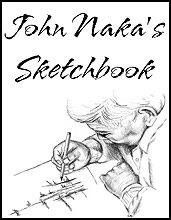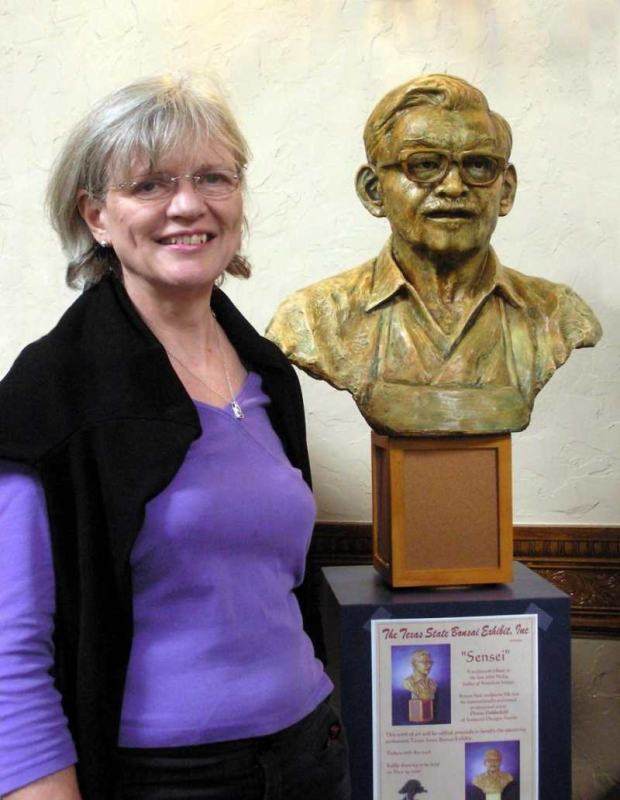|
And so, originally scheduled for release in the year
2002 was a new publication by the National
Bonsai Foundation, The Drawings of John Naka edited by Jack Billet and Cheryl Manning.

|
IN CELEBRATION OF A GRAND MASTER'S LIFE
PART V
This Page Last Updated: January 24, 2025
|
The January/February/March 2005 issue of BCI's
Bonsai
contained seven tribute articles and a timeline between pages 8 and 23,
plus with 19 color and 7 b&w photos, a color cartoon, and 3 line
drawings.
In May, the bonsai world gathered at the
John Y. Naka Pavilion of the National Bonsai and Penjing Museum in Washington, D.C.
as part of the World Bonsai Friendship Federation's Convention to
commemorate John's many contributions to bonsai. An impressive
film was shown about Saburo Kato and the late John Y. Naka, paying
tribute to these two men for their historic work in founding the WBFF,
which is dedicated to promoting peace through bonsai. The session
concluded with the ceremonial igniting of the Candle of Peace by Saburo
Kato. After a review of the exhibits of trees, scrolls, stones
and pots by Mr. Kato and Mike Naka, representing the Naka family, the convention program got underway with some
960 registered participants. His devotion to his teacher (guru) and mentor, the great John Naka was the part that really touched me. In ancient Indian culture, the Guru is the sum total of the trinity -- the creator Lord Brahma, the preserver Lord Vishnu and destroyer Lord Shiva -- the father and mother put together. Naka Sein [sic], from what I have know about him, was a true Guru. The kind we only get to read about in the old stories of India. Roy paid obeisance to his guru Naka and invited his grandson Michael Naka to the stage and said he would guide him in shaping the tree through his grandson's eyes.[sic] It was his ultimate reverence to the guru. He worked on the tree like a man possessed and the result was a masterpiece." 40 The first version of a Wikipedia article for John Naka was published in late March 2006. The Facebook group John Naka Bonsaï, Fans & Bonsaïka was established in March 2009. On June 28, 2009, a tribute video was screened at the Japanese American Cultural & Community Center (JACCC, the largest Asian American cultural center in the U.S.) 29th anniversary celebration and award dinner in Los Angeles. A Celebration of Heroes records those to whom the 2009 Pacific Pioneer Award was bestowed: community photographer Archie Miyatake, Nihon Buyo instructor Madam Kansuma Fujima, Urasenke tea ceremony instructor, Sosei Matsumoto, taiko performer Seiichi Tanaka, and bonsai master John Yoshio Naka (posthumously -- see the 3:35 mark, with some commentary by Mel Ikeda). Alice Toshiko Mizunaga Naka died on Aug. 1, 2011, per Cheryl Manning in the National Bonsai Foundation's Fall/Winter 2011 newsletter. A Facebook fan page was started Sept. 8, 2012. For John's centennial birthday celebration in 2014, a number of sources have put together reviews. These include this slide show on the North American Bonsai Federation's website about the five trees of John's in the National Bonsai and Penjing Museum in Washington, D.C. This wonderful video from 2014 by Cheryl Manning especially touches upon John's last few years. And the National Museum hosted an event on John's brthday featuring videos and photos of Naka at work, remarks by the Museum's assistant curator Aarin Packard, a display of Naka's bonsai from the Museum's permanent collection, and birthday cake. Starting at 2 pm, the celebration was free and open to the public. See also this video about John Naka (starting at the 5:52 mark) and Saburo Kato which was produced by the World Bonsai Friendship Federation and The Japanese American National Museum a few years earlier. On May 2, 2014 John became the first inductee into the National Bonsai & Penjing Museum's Bonsai Hall of Fame. 41 The 12-page October 2014 edition, Vol. 29, Issue 10 of the Dai Ichi Bonsai Kai Gazette has a section (pp. 5-9) on "John Naka Reflections." Danny Coffey's "National Bonsai, Part I: Goshin," was published by the National Bonsai and Penjing Museum in its "Tree The People" blog, June 30, 2015. A photographic history of the forest composition is presented. At the California Bonsai Society's 62nd Annual Bonsai Exhibit in collaboration with the Golden State Bonsai Federation on March 23, 2019, the historical reassembly of the bonsai masterpiece, Goshin III, an eleven-tree Foemina Juniper Forest, took place. A nearly two hour film captured the event led by Jack Sustic, former Curator for the National Bonsai and Penjing Museum at the National Arboretum in Washington, DC. He was assisted by Mel Carrillo, Mel Ikeda, Ted Matson and Doug McGowan at the Huntington Library, Art Collections and Botanical Gardens in San Marino, CA. Goshin III was originally created by John Naka in 1999, but was disassembled in 2015 because the planting was not thriving. A selection of replacement candidates for the trees that had been lost joined the original trees in the nursery, to be carefully tended until the time was right to replant "Goshin III." During the process, Jack gives some commentary and background on the forest and John. The John Yoshio Naka Memorial Bonsai Exhibiion 2019 is preserved in pp. 10-21 of the September 2019 edition of The Dai Ichi Gazette. The National Bonsai Foundation republished in its blog the October 16, 2020 article "Influential Bonsai Master: John Naka" on that November 19. Artistreebonsai's blog from November 17, 2022 is about one of the two special exhibits at the Pacific Bonsai Expo 2022, "How Big Was Naka's Bird?." From August, this video of the "2024 John Yoshio Naka Memorial Bonsai Exhibition - Baikoen Bonsai Club." Ryan Neil's master class in handling of a tree from Bonsai Techniques II in a two-part video from late January 2025, "John Naka Juniper Restyling Pt. 1: California Juniper Transformation." |
|
At the annual National Bonsai Foundation board meeting in 2000, the board
approved a suggestion to have copies of John Naka's drawings collected
for the National Bonsai & Penjing Museum. Over the years, John
had drawn hundreds of these "future images" of bonsai in training, and
many of his students kept them as prized possessions.
(John often saw something unusual for a tree, then related it to something profound (or sometimes engagingly witty) for the viewer. Frankly, this insight into "connections" was as important an aspect to John as his actual design.) By assembling these drawings in one place, any number of options present themselves including possible publication of material that would be a rich resource for bonsai design. At the very least, having the drawings at the Museum would establish a great collection for researchers. To accomplish the task, board director Jack Billet volunteered to collect data by mail. Jack asked for contributors to make photocopies of their original drawings sized to fit on a standard size sheet of typing paper (8-1/2" x 11"), so that the drawings could be maintained in a relatively generous size but not too large as to be unwieldy. For reference purposes, Jack proposed that the original owner of the drawing, and when and where drawn, be identified. Identifying the bonsai material by genus, species, and cultivar would also help categorize the drawings. For "place," both the bonsai event and the city would be identified. If there was an anecdote contributors wished to share regarding the drawing, something John might have said (profound or engagingly witty) that he thought connected with the actual design, it was requested that it be included also. Finally, a note that either confirmed or denied permission for the Museum to publish (either in print or in Internet form) a copy of the drawing provided was required. Thus, an accompanying sheet might read: |
|
ORIGINAL OWNER: DATE DRAWN: PLACE:
SPECIES, et al:
ANECDOTE:
PERMISSION TO PUBLISH |
John Doe 5/1/1984 Golden State Convention workshop; Fresno, California, USA
Dwarf Black Spruce -- Picea
John said not to be so concerned about the amount cut-off. "It'll grow more."
Yes
|
|
And so, originally scheduled for release in the year
2002 was a new publication by the National
Bonsai Foundation, The Drawings of John Naka edited by Jack Billet and Cheryl Manning.

|
In January 2007, the Texas State Bonsai
Exhibit, Inc. announced a raffle of a life-size bronze bust of John. Sculpted
by the internationally proclaimed professional artist Donna
Dobberfuhl (who is also a member of the group), this unique object d'art was
raffled on May 19, 2007. Proceeds benefited the upcoming permanent world-class Texas
State Bonsai Exhibit in Austin, Texas. The original molt of this now famous bust is at Donna's atelier. A different
bronze of John (without glasses) on a stone base by Bonnie Kobert is at the National Bonsai and Penjing Museum in Washington, D.C.
43

Sculptor Donna Dobberfuhl with her bronze bust of John Naka, entitled Sensei |
|
The above biography and the linked ones on this site were initially from the unpublished
notes for a comprehensive history of our art, Magical Miniature Landscapes
by Robert J. Baran. Much of this material is being incorporated
elsewhere on this web site.
Some of the Naka material, without the below bibliography, was included in
Designing Dwarfs in the Desert, up through the first 35 years of the Phoenix Bonsai Society
(November 1997, Pyramid Dancer Publications).
John Naka had taught in Phoenix before our club was officially formed,
and continued to come over to teach us and our teachers for many years. We are very much aware that John Naka had been a teacher to at least two generations of bonsai enthusiasts and artists worldwide. The above biography is definitely not intended to be the final look at this great man's life. On the contrary, let this be the first seed planted for a whole forest of Web-available material on him. Another dimension to our teacher's life and work was told with the "John Naka Tribute" in the NABF Newsletter #1 (http://web.archive.org/web/20060126085701/http://www.bonsai-wbff.org/nabf/newsletter1/newsletter1index.htm). See also the variety of articles about John on Cheryl Manning's site (http://www.betterbonsai.com/contents.html). And "A Tribute to John Yoshio Naka" at the Art of Bonsai Project (http://artofbonsai.org/galleries/naka.php). An illustrated chronology of Goshin can be found in this BonsaiEmpire blog, http://www.bonsaiempire.com/blog/goshin. Additional background on the other teachers and organizations mentioned above will be linked as it is discovered and reviewed. Please e-mail rjb@magiminiland.org with additional events, anecdotes, graphics, or other Web sites concerning John. Thank you very much. |
|
|
|
|
|
|